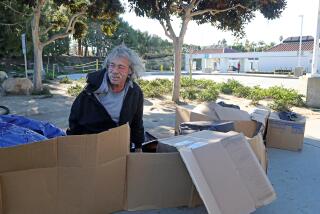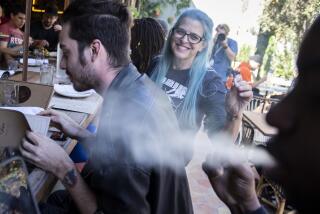Santa Monica OKs Plan to Filter Out Restaurant Smoking
Jon Sedillos, an accountant, stood before the Santa Monica City Council and placed on his head a blue golf cap with a small motorized fan attached. He turned on the fan.
“This is my Santa Monica restaurant hat,” Sedillos said. “The fan is designed to blow cigarette smoke from my face. But even I don’t always like to look like a fool to enjoy my meal.”
Sedillos, who said he gave away a Dodgers playoff ticket to be at the Tuesday night meeting, drew laughter from the council members. But he also had made his point.
The council, after 3 1/2 hours of debate, voted overwhelmingly late Tuesday to give preliminary approval to a moderately tough smoking ordinance for all restaurants in the city.
If the law is given final approval at a second reading in two weeks, eating establishments throughout Santa Monica, including some of the trendiest on the Westside, would be required to set aside at least 60% of their seats for nonsmokers.
The vote was 6 to 1, with Councilwoman Christine Reed dissenting, saying it was unfair not to exempt small restaurants.
The ordinance that passed was a meshing of two draft versions that have generated considerable controversy and has caused the council to do something of a flip-flop.
Restaurant Lobby
Last January, the council considered and voted down a strict proposal that would have required all restaurants to designate 70% of their seats for non-smoking sections.
At that meeting, after hearing from a particularly strong restaurant lobby, the council voted 6 to 1 to have the law rewritten. The new version reduced the no-smoking section from 70% to 50% of a restaurant’s seats and established several exemptions, including restaurants with fewer than 50 seats.
But when the new version came up for a vote Tuesday, the council consensus seemed to shift back to favoring what the majority had rejected just nine months before.
Councilman Alan Katz moved to return to the original ordinance with the 70-30 breakdown, while maintaining some exemptions, such as bars and banquet rooms. He was backed by Councilman David Finkel, who has sided with the toughest-possible ordinance since January.
Reed tried to restore the 50-50 breakdown but failed. Councilman Herb Katz (no relation to Alan) suggested a 60-40 ratio, which was approved.
Reed, who cited the importance of a “healthy” restaurant industry to Santa Monica’s tourism business, then added several more exemptions, such as boarding houses, nightclubs, public school cafeterias and sandwich stands.
She also tried unsuccessfully to delay a vote on the final measure, saying owners of smaller restaurants--who did not appear at Tuesday’s meeting as they had at the January session--should be given a chance to object to the fact they were no longer exempted.
No ‘Smoke Police’
“We are overreaching here. . . . “ Reed said. “You are creating a very extreme difficulty for the smaller, mom-and-pop restaurants. It is important we start out in a manner that is essentially conservative . . . start out slowly and then work our way forward.”
An apparently exasperated Alan Katz seemed to lose patience with Reed’s amendment-making.
“It’s not like we’re going to have smoke police watching whether people light up,” Katz said. “This is a statement to visitors and residents that a no-smoking ordinance is important. This is an ordinance that will work in the real world.”
In fact, Santa Monica--usually in the avant-garde on social issues--had fallen behind most neighboring cities in adopting restaurant smoking laws.
Health Advocates Prepared
Public health advocates had assumed that Santa Monica would easily pass the original tough ordinance in January. They found themselves overpowered by representatives of the restaurant industry.
This time, they left nothing to chance.
A contingent of 18 people, including several doctors, urged the council to pass the strictest possible law. Four restaurateurs voiced support for the weaker version and asked that there be flexibility for eatery operators to shift non-smoking sections on a night-by-night basis as customers demanded.
Russell Barnard, who owns Tavern on the Main on Main Street and who spoke on behalf of the Santa Monica Chamber of Commerce, said after Tuesday’s vote that he was glad to see an ordinance but regretted the fact that smaller restaurants were not exempted.
“It is surprising that a city this progressive has been this slow (in passing a no-smoking law). But perhaps that created a feeling of guilt that made (council members) overreact,” Barnard said.
“To not exempt the smaller restaurants is foolish. And it may be an economic disaster,” he said.
Barnard, whose restaurant seats 36, with 84 more seats at the bar and outdoor patio, said small-restaurant owners had not attended Tuesday’s meeting because they were happy with the January version of the law. They had “significant confidence” that law would stand, he said.
Dr. Harvey Frey, a retired Santa Monica radiation therapist who organized much of the opposition to the weaker ordinance, said he was generally pleased with the law but expressed disappointment with Reed’s last-minute addition of exemptions.
“The simple rules of equity would demand that the non-smoking majority should not suffer because of the activities of a small minority,” Frey told the council.
Total Smoking Ban
Some speakers advocated outlawing public smoking altogether.
“One smoker can ruin a meal for 12 or 15 people, while my non-smoking impinges on no one,” said Dr. Allana Elovson, a research psychologist who teaches at the California School of Professional Psychology.
“(Smoking) is something that can be done, between consenting adults, in the privacy of their home.”
From the restaurateur flank came pleas for the council to recognize the “reality” of the restaurant business.
Rudy Cole, a former spokesman for the Beverly Hills Restaurant Assn., which successfully fought a 100% no-smoking ordinance, warned council members that they were attempting to legislate against visitors from out of town, while hurting local business.
And Gerald Breitbart, spokesman for the California Restaurant Assn., said he realized the pragmatic need for some sort of ordinance but suggested that no-smoking laws are like regressive taxes.
“Smoking is the greatest among blue-collar and low-income (people). To talk about the impact on white-collar customers and not (consider) the low-income is not being fair.”
The council will give the ordinance a second reading and final vote Oct. 25.
The restaurant smoking-section law is an addition to a 1984 comprehensive ordinance that banned smoking in numerous public sites, such as grocery stores, elevators and public restrooms.
NO-SMOKING ORDINANCE
The ordinance will require every restaurant in Santa Monica, regardless of size, to set aside at least 60% of its seats for nonsmokers.
Exempted from the law are bars, nightclubs, cocktail lounges, banquet rooms, sandwich stands and public school cafeterias.
Restaurant owners will have to post signs designating smoking and non-smoking sections.
The ordinance will have a second reading and final vote Oct. 25.
More to Read
Sign up for Essential California
The most important California stories and recommendations in your inbox every morning.
You may occasionally receive promotional content from the Los Angeles Times.











